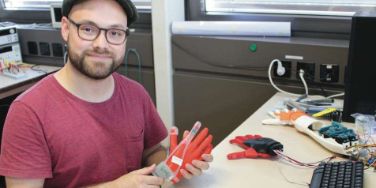- News
Feeling with your feet: high-tech hand prosthesis relays tactile sensations to the sole of the foot
05.07.2023 Prosthetic hands do not provide users with information about how hard or soft an object is. To overcome this, scientists at the Institute for Human Centered Engineering HuCE at BFH have been researching innovative sensor feedback systems for several years.
Myoelectric hand prostheses, which are controlled by minimal signals from the muscles in the residual arm, restore many functions of the hand to the wearers. What they cannot do, however, is replace the sense of touch. Previous projects have attempted to relay the tactile sensations to the arm using a sensor system and small vibration motors. There is usually not enough space for the motors in the shaft of the prosthesis, though, and they would add extra weight to the device regardless of this. Researchers from the Institute for Human Centered Engineering HuCE at BFH got together with experts from Balgrist University Hospital to pursue a novel approach: with the appropriately named FeetBack system, the feedback from the sensors can be felt on the sole of the foot instead of on the arm. This is possible thanks to a sensor glove and a special insole with built-in thin vibration motors.
Information through vibrations on the sole of the foot
The researchers integrated a total of five motors into the insole. By the speed with which the vibration ‘travels’ from the toes to the heel, the person can estimate how hard an object is. In addition, the intensity of the vibration indicates how strongly an object is being held. To test the system, the researchers conducted a pilot study with four test persons. In the first experiment, the blindfolded prosthesis wearers had to sort objects by hardness. The second experiment involved removing the stem from cherries. For this, the test persons had to hold the cherry with the prosthesis and remove the stem with the other hand. While the test persons mastered the first experiment well, the second task turned out to be more difficult. This was presumably because the prototype is too slow, too imprecise and not intuitive enough. In drawing their conclusion, the researchers deemed the underlying principle of sensory feedback a success that deserves a better implementation in the future.
Good alternative to sensory feedback to the arm
The results obtained in the pilot study fell in line with those obtained in tests with feedback systems directly on the residual arm. In other words, when it comes to sensor feedback systems, the relaying of the tactile sensations to the sole of the foot represents a good alternative to sending feedback directly to the arm, with the advantage that the hand prosthesis does not have to become bigger and heavier.
Cybathlon team benefits from the insights
The Cybathlon team ‘BFH-Hand-X’, which is due to take part in this unique competition in 2024 in the Arm Prosthesis Race category, is among the first to benefit from the knowledge and experience in the field of rehabilitation technology gained through the project. At the Cybathlon, people with physical disabilities compete as they perform tasks related to everyday life supported by state-of-the-art assistive technology systems. Rafael Morand, who worked as a research associate on the FeetBack project, will contribute his knowledge to the BFH-Hand-X development team.
Rafael Morand
Rafael Morand was employed by Prof. PD Dr Volker M. Koch from 2018 to 2023, which enabled him to gain valuable academic and industrial experience. He worked in industry-centric projects on the development of medical technology with sensors and system verification. He also played a leading role in the clinical study on FeetBack, in which he performed the study design, the measurements with study participants and the data analysis, and published the study in a renowned journal. His next post is a PhD position at the Department of Neurology at the University Hospital Inselspital Bern in the group of the Dean of the Medical Faculty of the University of Bern.
Contact


